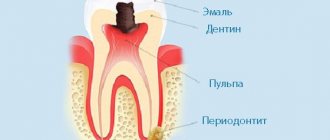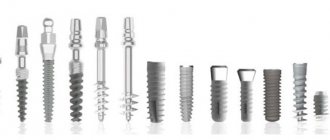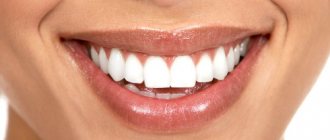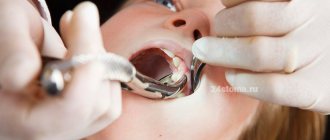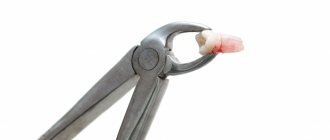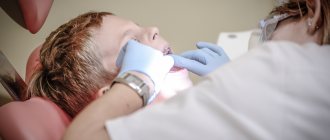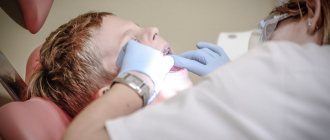Toothache has different manifestations and causes. Carious destruction of enamel, trauma, damage to the mucous membrane, gum disease and even the eruption of permanent units can provoke discomfort, cause fever and general ill health. While waiting for an appointment with a doctor and an accurate diagnosis, parents should be able to conduct an independent diagnosis - calm the baby and provide first aid. To do this, it’s worth figuring out why and what to do if a child at 3-4 years old has a toothache.
Can a child’s baby teeth hurt: dental problems in children
Parents often ask: can baby teeth hurt in a 2-5 year old child? The answer from dentists in this case is always positive. Baby teeth are also susceptible to caries, just like permanent teeth. Moreover, superficial caries can quickly develop into deep caries - causing pulpitis and periodontitis.
Although caries is the main answer to the question “can baby teeth hurt in a 4-year-old child,” there are other dental diseases that provoke complaints in a child. Among them:
- enamel erosion;
- dental hypersensitivity;
- mechanical tooth trauma;
- stomatitis;
- gingivitis;
- periodontitis.
Gum diseases and mucosal ulcers are also included in this list, since a 3-5 year old child will say that his teeth hurt, and will not indicate the true problem.
Physiotherapy
Increases the effectiveness of the drugs used and speeds up recovery. If the disease often causes bleeding and pus, you must wait until these symptoms disappear. If otitis media is painless, physical therapy can quickly cure it.
- A magnet is applied to the affected area to relieve pain.
- Rinsing the ear prevents the spread of infection and the development of complications. The procedure is uncomfortable, but effective.
- Electrophoresis allows you to administer medications through the mucous membrane and skin, which helps to achieve a therapeutic effect even when using small doses.
- UHF. It has an anti-inflammatory effect, accelerates metabolic processes, and helps relieve discomfort during otitis media.
To help parents: home diagnostics based on the nature of pain and indirect symptoms
Children often complain of toothache, including any discomfort in the oral cavity in this category. The task of parents is to understand what worries the child. A small cheat sheet on dental diseases will be an assistant in diagnosis:
- Caries. At the initial stage, it is noticeable in the form of white matte spots, which gradually darken to brown or black with the formation of holes. Pain manifests itself when there is pressure on a tooth, when pieces of food enter the carious cavity, or as a reaction to cold or hot.
- Pulpitis. It is not always accompanied by severe pain, although with significant nerve damage, the disease causes severe anxiety in the child. External signs are swelling of the soft tissues around the diseased unit, a change in the shade of the tooth.
- Periodontitis is the next stage of the disease with advanced pulpitis. A lump forms on the gum. The pain is sharp, especially when touching a tooth.
- A fistula is a small bubble on the gum, usually under a filled tooth. A symptom that pus has accumulated in the inflamed area and requires release. The pain is temporary and not permanent. Without treatment, there is a high probability of damage to the rudiments of the radical units, so a visit to the dentist is a necessity.
- Flux is an inflammatory process of the periosteum, accompanied by swelling on one side of the face and severe pain in the tooth. A sharp rise in temperature is possible.
- Enamel erosion is a non-carious darkening of the tooth surface that occurs as a result of poor hygiene or an unbalanced diet. Pain occurs as a response to irritating factors - hot food, cold drinks.
- Stomatitis is painful sores, white plaque or pimples in the mouth. In advanced cases, there is general malaise and fever in the child.
- Gingivitis and periodontitis are inflammation of the gums with severe swelling and redness. The pathological process is accompanied by pain and tooth mobility.
- Teething can be painful, both in very young children and in school-age children when molars appear. Signs of the eruption of baby and permanent molars are swollen gums, increased salivation, poor sleep, temperature fluctuations.
Rodikova Tatyana
Parents do not believe that teething in schoolchildren can be very painful. Especially if the first teeth grew easily and imperceptibly. I would like to note that molars can take a long time to erupt - with fever, swelling and refusal to eat. If your child experiences these symptoms, it is worth making an appointment. The doctor will accurately assess the baby’s condition and suggest how to facilitate the growth of new teeth.
Types of disease
Our ear consists of three areas: outer, middle and inner. The first is the visible part of the ear, which in everyday life we call the ear. The middle and internal sections are not visible and have a complex structure. The appearance of acute inflammation of the ear in children can affect each of its parts, so the diagnosis is divided accordingly into external, media and internal otitis.
Two thirds of recorded cases of the disease are acute otitis media. In children under one to two years of age, this percentage is even higher. Since pathogenic microorganisms enter the middle ear from the nasopharynx.
Acute inflammation of the middle ear is represented by catarrhal, exudative and purulent stages. Catarrhal inflammation is considered an acute inflammation of the initial stage. During this period, the patient begins to feel congestion in the ear and hearing loss. In the exudative form, a viscous secretion is formed - it is this that accumulates that causes pain. A distinctive feature of the acute process of this type of inflammation is suppuration from the ear. This is the most severe type of the disease, accompanied by high fever.
If acute otitis media in children is not treated, the development of internal otitis media begins - labyrinthitis. For children, this condition is extremely dangerous and requires proper treatment. Otherwise, the consequences can be very serious.
Make an appointment right now!
Call us by phone or use the feedback form
Sign up
Based on the duration of the disease, otitis media is divided into acute, subacute and chronic. The acute course of the disease is characterized by a rapid onset, this condition lasts no more than three weeks. If a child’s illness lasts from three weeks to three months, we talk about the subacute form. If an acute disease is not treated or the acute inflammatory process is treated incorrectly, the inflammatory process will become chronic. This disease will already last for more than three months.
Baby tooth hurts after treatment
Pain in a baby tooth after treatment is also not uncommon. And here parents should carefully monitor the baby to understand the cause of the complaints:
- Poor quality treatment. The doctor did not clean the root canals well and did not place a sealed filling. There is only one solution - make an urgent appointment with the dentist and repeat treatment with a good dentist.
- Residual discomfort. This happens when the treatment is complex and soft tissues are injured during drilling or dental procedures. Adults should think about how to relieve a child’s toothache at home - give a painkiller or rinse. If you have long-term complaints, you should make an appointment with a doctor for a consultation and re-examination.
- Allergic reaction to materials and drugs. Allergies most often manifest themselves as itching, but can also cause pain. If the cause of the reaction is an anesthetic used by dentists, it is worth giving a suitable antihistamine. In other cases, you cannot do without visiting a doctor.
Marina Dolotova
You can find cheap dental clinics in Moscow, but it is always worth assessing the health risks. Children with poorly placed fillings are increasingly being brought to Azabuka. And, what’s worse, with prolonged inflammatory processes. Kids cry and complain. I treat teeth and reassure both patients and parents. Such practices are very sad.
Drug therapy
Treatment should be comprehensive and aimed at eliminating the source of the disease:
- If the inflammation is external, then it is advisable to use antibiotics and NSAIDs in the form of ear drops. The otolaryngologist prescribes Garazon or Sofradex.
- For inflammation of the inner ear, Miklisin and Diphenhydramine are prescribed.
- For external use, Levomikol ointment is used, the active ingredient of which works as a local antibiotic.
- Vasoconstrictor drops Rinostop, Xylene relieve swelling of the mucous membrane and improve ventilation of the ear canals.
- The use of analgesics and painkillers for otitis improves the general condition of the patient, because these drugs not only reduce the temperature, but also relieve discomfort of various types. Painkillers for otitis media relieve ear and jaw pain and lower the temperature. The most affordable and popular painkillers are Ibuprofen or Paracetamol. They are approved for use at any age.
For otitis media, drops containing lidocaine are effective. These are Otipax and Anauran. The first is used to treat children of any age, even newborns, the second - from 1 year. Dosages are prescribed depending on the age of the patient.
Adults can take, in addition to non-steroidal anti-inflammatory drugs in the form of Paracetamol, Propyphenazone. The active substance of the same name is part of the drugs Pentalgin Plus or Novalgin.
Ear drops should be at room temperature. If there is pus discharge from the ear, these medications should not be used. Since treatment differs for different manifestations of the disease, all groups of medications should be prescribed only by a doctor. One group of drugs may be effective for treating otitis externa, but is contraindicated for otitis media. Before visiting a medical facility, you can use medications that relieve discomfort and alleviate the general condition.
The otolaryngologist takes into account the presence of side effects, especially when prescribing the drug to children. Substances that are not recommended for children may be used if there are no alternative treatments.
After otitis media, it is important to follow your doctor’s recommendations, take vitamins and lead a healthy lifestyle.
A child’s baby tooth hurts and is loose: treat or remove
Sometimes a child's front baby tooth hurts and becomes loose. Increased mobility can be caused by a planned change of bite or injury. A child’s front teeth hurt after an unsuccessful fall, a blow in the sports section, or minor bicycle accidents. A doctor will be able to remove the consequences of mechanical impact after an x-ray and examination of the oral cavity.
If a permanent tooth is cut under a temporary tooth, and this causes pain, the doctor, of course, will recommend removal. But this is the only option when removal is preferable. In all other cases, teeth with primary temporary occlusion should be protected - fillings should be placed, caries and pulpitis treated, and gum inflammation relieved. It is not worth getting rid of a diseased tooth in the hope of a permanent bite - with early removal, pathological changes in the primary and permanent units and serious orthodontic problems in the future are possible.
How to relieve pain from otitis media?
The auditory canal in humans is located in the temporal bone of the skull. With otitis media, edematous tissues of the outer or middle ear press on the walls of the bone receptacle, which causes unbearable headaches in patients. It can be shooting, sharp, aching, dull. Such pain significantly disrupts a person’s well-being and activity, and in children it is a cause of constant anxiety. The only salvation in such situations is painkillers.
Pain during inflammation occurs as a result of compression of sensitive nerve endings by edematous tissue. Destroyed cells and pathogenic microorganisms release certain substances - inflammatory mediators. They trigger further reactions of the body. Blood flow to the site of injury increases, blood vessels dilate, and their permeability to plasma and immune cells increases. As a result, edema develops, limiting the further spread of the pathogenic factor.
In addition, pain is caused directly by substances of destroyed cells and toxins of microorganisms. The pain impulse generated in the receptor is transmitted along the nerve fiber to the brain. It is electrical in nature, and the process itself is reminiscent of signal transmission through a cable. The brain receives information about trouble and interprets it as pain. You can eliminate it in several ways:
- prevent the inflammatory reaction or reduce its intensity;
- block the transmission of pain impulse.
There is a third method of pain relief - acting directly on the pain receptors of the brain. This is how opium works, for example. However, with otitis media the need for narcotic analgesics is an extremely rare situation.
A child’s baby tooth hurts: what to do at home
How to help a child with a toothache is the main question when waiting to see a dentist. There are several options:
- folk remedies;
- medication assistance;
- massage.
Traditional methods of relieving toothache
If a child’s baby tooth hurts, folk recipes will tell you how to relieve the pain. There are many of them, but you should choose only herbs and tinctures, the use of which is acceptable for the specific age of the baby. Rinsing will help cope with painful teething and relieve discomfort after filling:
- Warm decoction of sage, chamomile or lemon balm.
- Propolis tincture, slightly diluted with water.
- Oak bark brewed for rinsing.
- Soda solution.
Painkillers
When a 5-year-old child has a toothache, there are usually no questions about what to do. The first thing parents remember is medications that can alleviate the baby’s condition before seeing a doctor. The most popular means:
- gels and ointments - with a cooling, anti-inflammatory, antibacterial and analgesic effect;
- syrups and tablets are medicines in which the active ingredient is paracetamol or ibuprofen.
An alternative solution would be homeopathic preparations - drops, suppositories and ointments based on plant substances.
Massage to relieve toothache in a child
What to do if a child has a toothache, and medications and homeopathy do not help. You can use the secrets of oriental medicine and try acupuncture massage:
- Fingers - you need to massage the index and middle fingers on the hand opposite to the diseased tooth. At least 7 minutes. The second option is to stroke and lightly press the area between the index and thumb on the side of the diseased tooth for about 5 minutes in a circular motion.
- Ears – you need to massage the upper part of the ear in a circular, soft motion. Within 5-7 minutes.
- Jaws - smooth circular movements with your fingers at the base of the disturbing jaw will help relieve pain.
Unconventional methods of pain relief
Folk remedies are used as adjuvant therapy to relieve pain in otitis media. It should be remembered that, as the main medicinal herbs in an acute process, they will be ineffective.
Camphor oil is widely used for ear pain. It is instilled or placed with the help of a turunda into the ear canal for 20 minutes. The drug is preheated to body temperature.
Another recipe is popular: onion juice is mixed with flax or almond oil in a 3:2 ratio. Drip into the sore ear three times a day, then cover the ear canal with cotton wool.
A plant such as geranium is considered the best natural anesthetic. To reduce pain, you need to crush the sheet, wrap it in a bandage and insert it into the external auditory canal.
What not to do if a child’s baby tooth hurts
When the question is how to relieve toothache in a child 3 years old or older, several actions are strictly prohibited. Among them:
- warming - do not heat a sore tooth;
- cooling - cold relieves pain, but the facial nerve can get cold;
- compresses – active substances in compresses often provoke allergic reactions and chemical burns to the baby’s delicate skin;
- strong painkillers - adult medications are contraindicated for children even with the most severe toothache;
- feed the child spicy foods - as well as very cold or hot ones, since aggressive exposure increases the pain.
Effective formulations for children
In pediatric pediatric and ENT practice, only safe drugs are prescribed.
- ANALGIN. It is used only in extreme cases when there are appropriate medical indications. If you disobey, this can lead to anemia, lack of immune cells in the blood, and thrombocytopenia.
- KETOROLAC. The drug is prescribed for intravenous administration in case of severe pain. For the treatment of otitis, this composition is not used as an independent medicine.
- PARACETAMOL. This is a syrup that is prescribed at 10-15 mg depending on body weight. The number of times a day is 4-6, depending on the degree of damage.
- SARIDON. This drug is sold in tablet form and is prescribed to children over 12 years of age, half or a whole tablet twice or thrice a day.
- LIDOCAINE. It is included in many drops and is used 2-3 pieces three times a day for no more than one week.
